Abstract
Toxoplasma gondii has a coccidian life cycle in the intestine of domestic and wild felids that includes a series of asexual and sexual stages and an oocyst stage that is shed in the feces. Oocysts complete their development outside the body, eventually becoming infective for about 350 species of vertebrates including cats and man. The effects of climate on oocyst survival and the physical and biological means of oocyst dispersal are discussed. Infectivity and pathogenicity for livestock species vary. Acute disease results from rapidly multiplying tachyzoites that may be transmitted by carnivorism, transfusion, vertical transmission and other routes. Patent infections may persist for the life of a host as bradyzoites within tissue cysts. Bradyzoites initiate acute infection in other hosts after carnivorism or organ transplantation or in the same host after immunosuppression. Also discussed are: (a) prevalence of T. gondii in livestock as determined by digestion and serological techniques, (b) identification in humans as accomplished by isolation, serological and skin test techniques and (c) identification in cats as accomplished primarily by fecal examinations for oocysts infective for mice. Source of human infections, major outbreaks, treatment, effects on mental health and methods for preventing toxoplasmosis in man and livestock are listed.
Full text
PDF
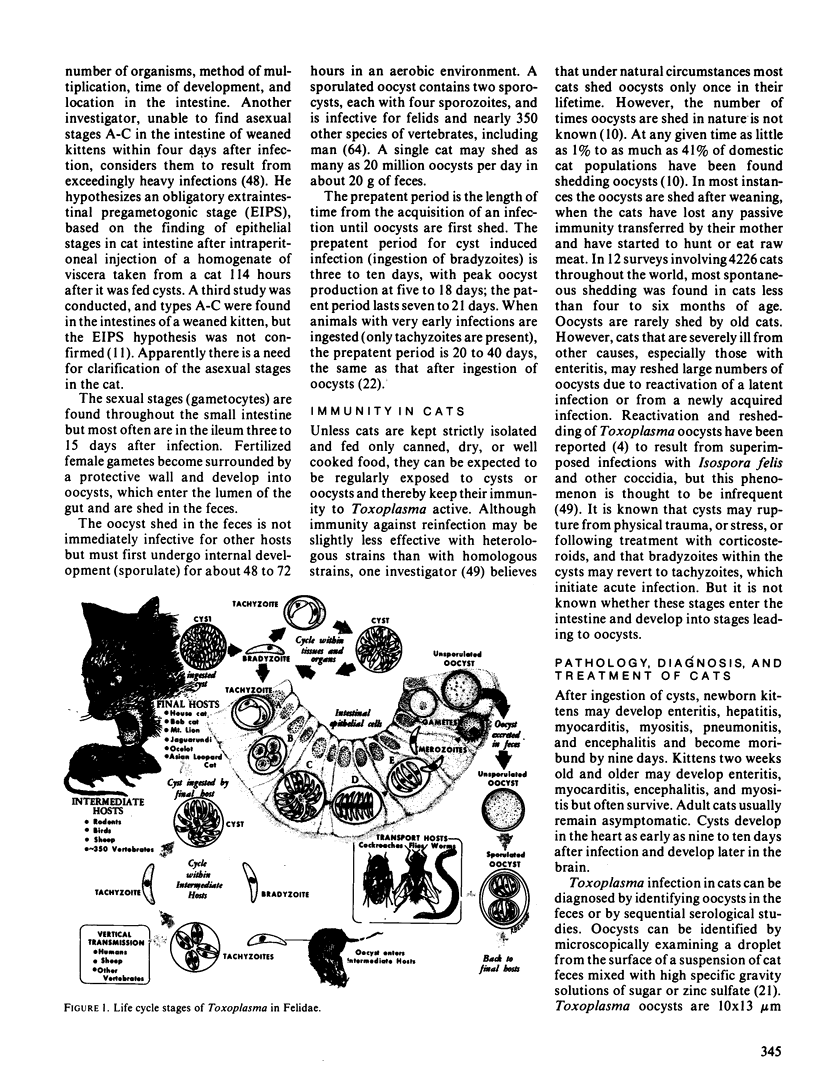
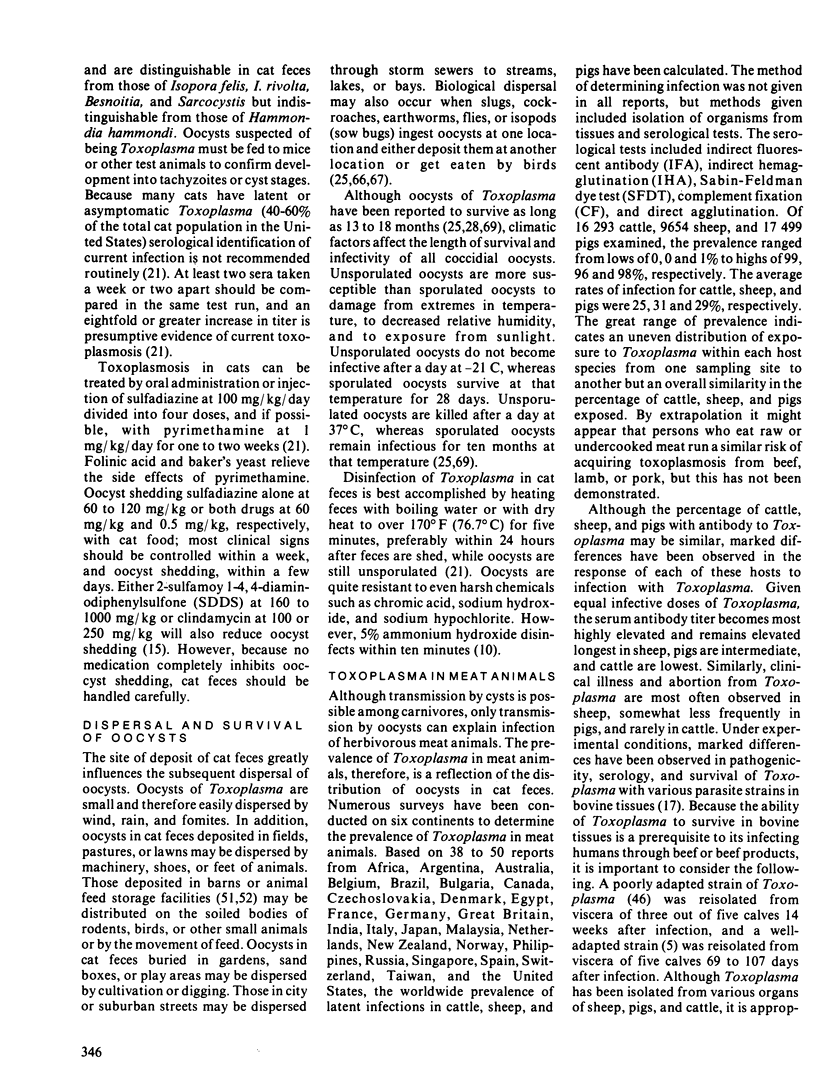
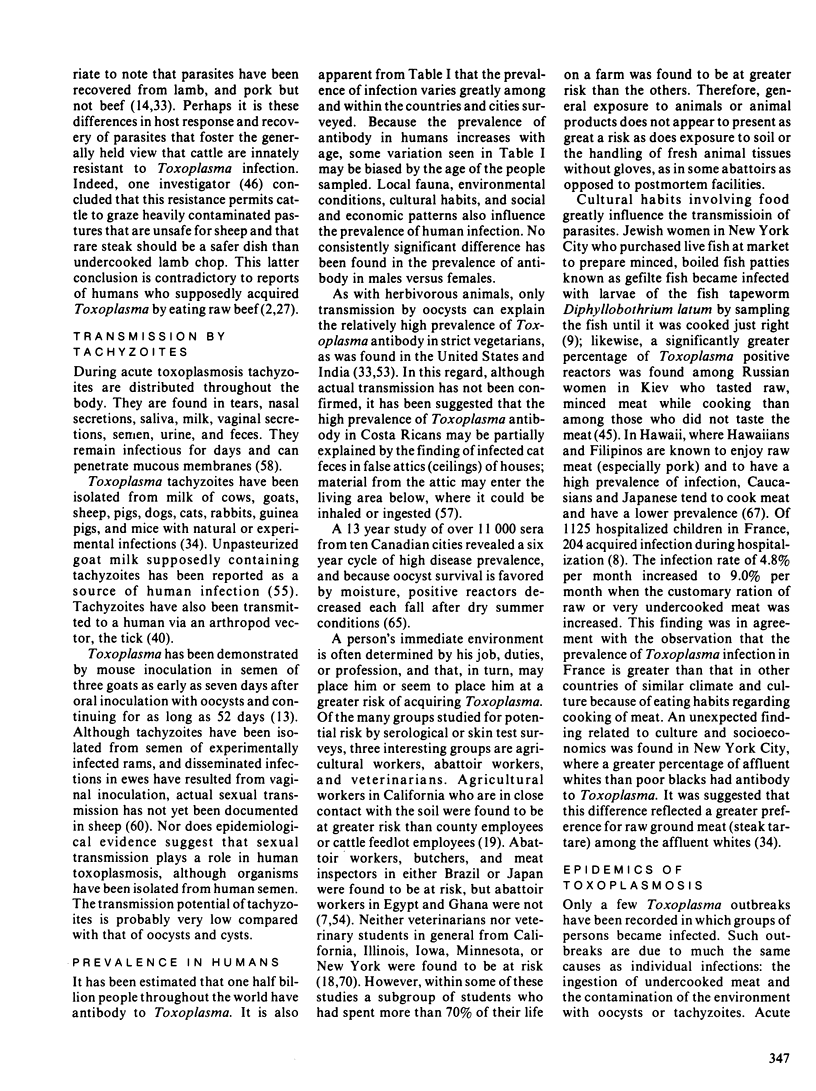
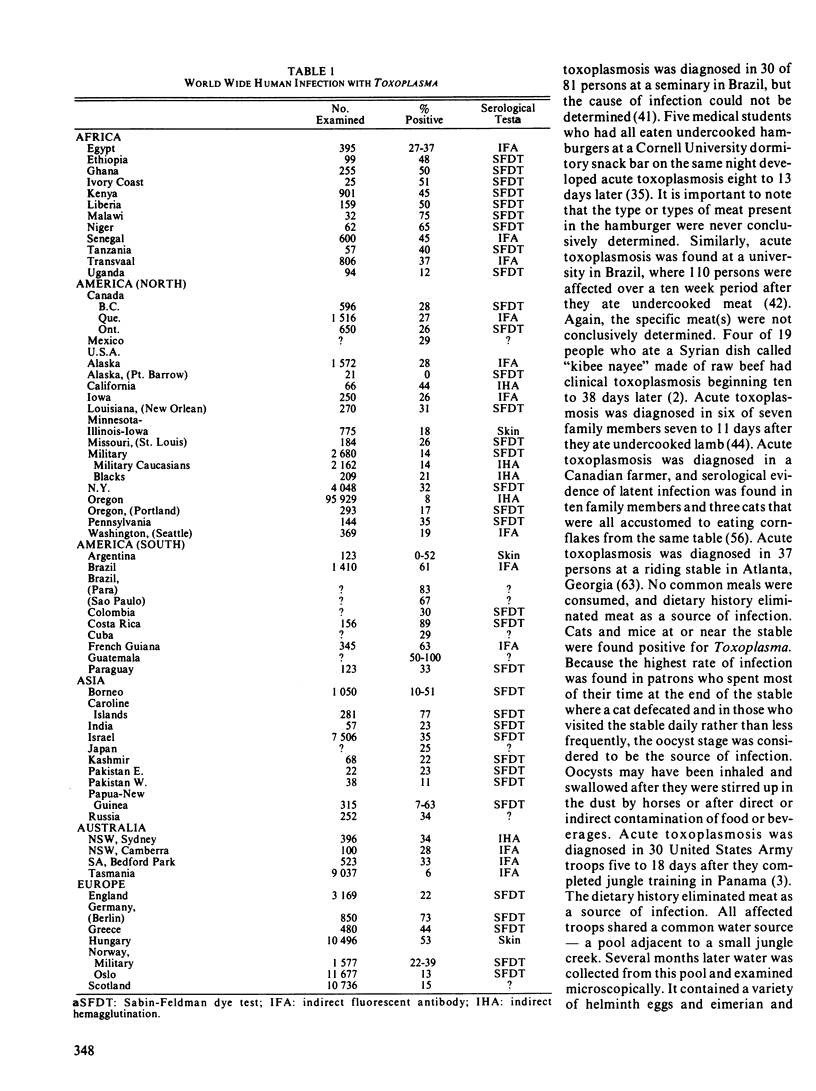
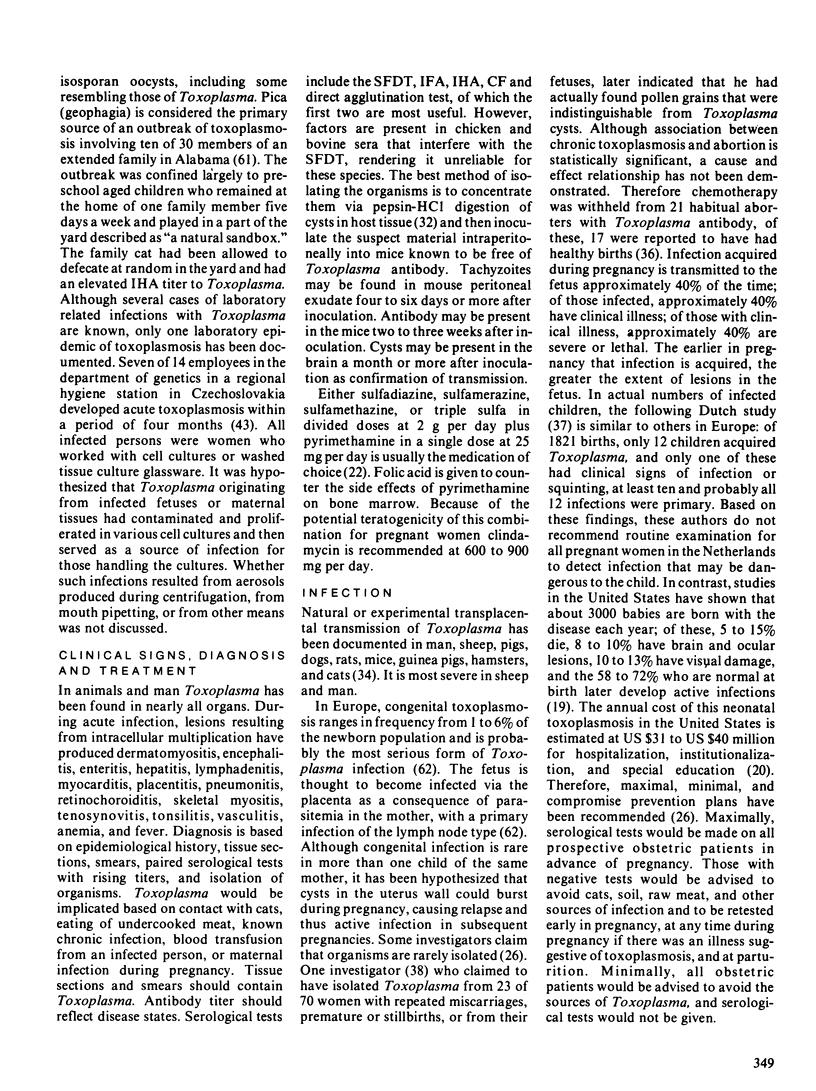
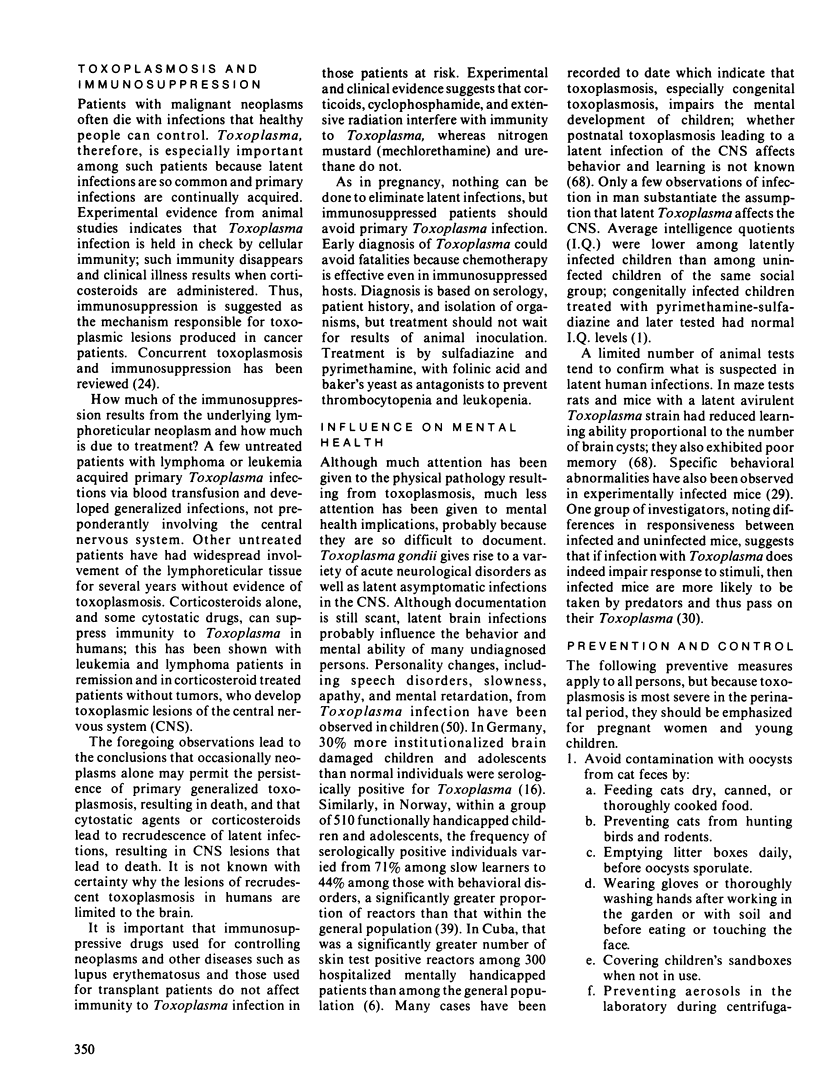
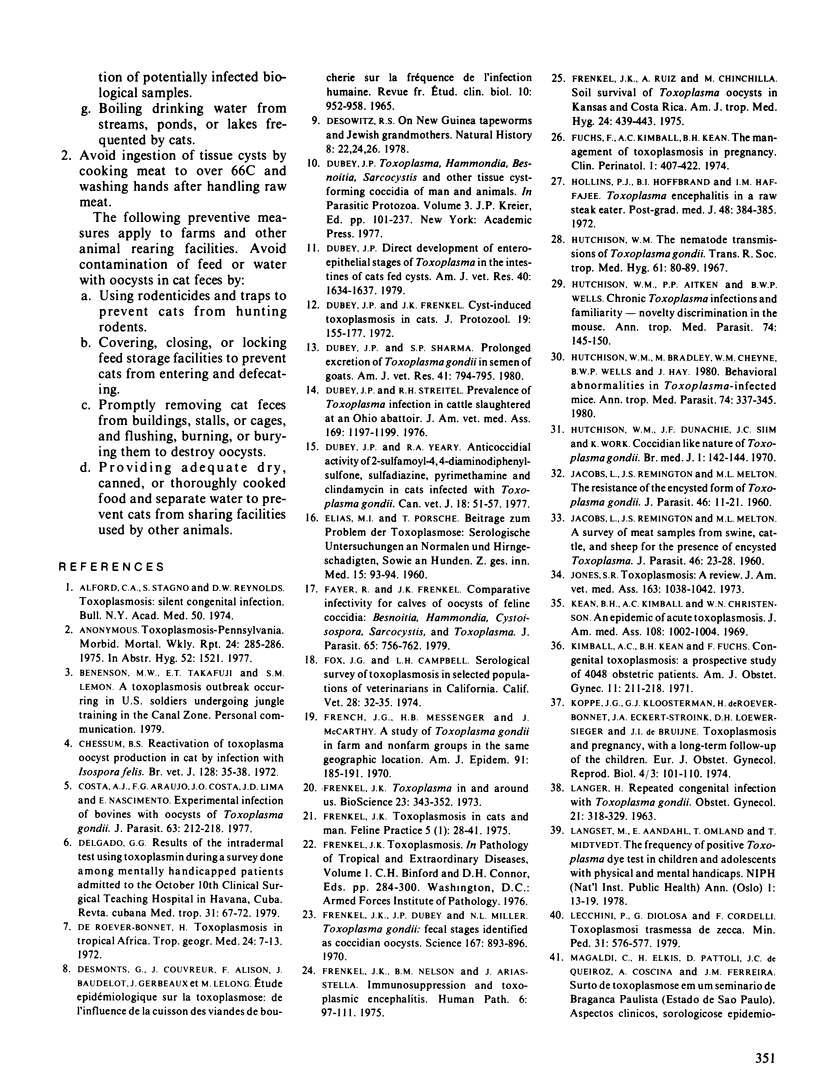
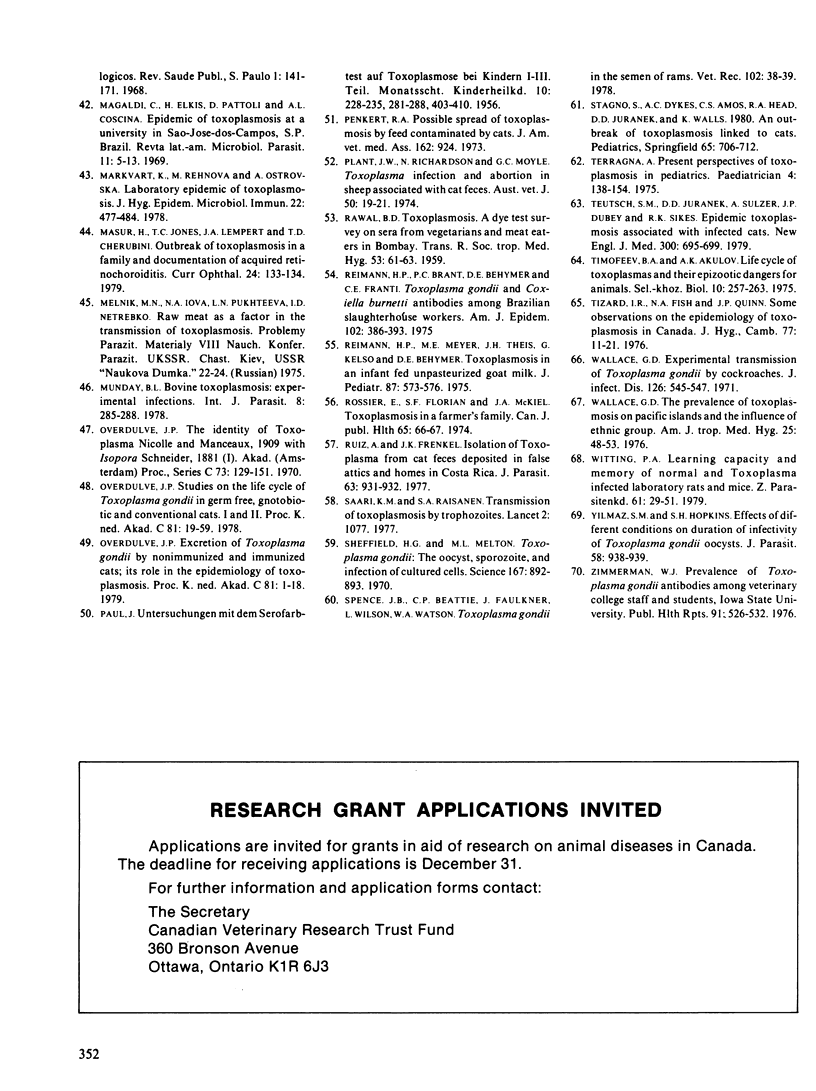
Images in this article
Selected References
These references are in PubMed. This may not be the complete list of references from this article.
- Costa A. J., Araujo F. G., Costa J. O., Lima J. D., Nascimento E. Experimental infection of bovines with oocysts of Toxoplasma gondii. J Parasitol. 1977 Apr;63(2):212–218. [PubMed] [Google Scholar]
- Dubey J. P. Direct development of enteroepithelial stages of Toxoplasma in the intestines of cats fed cysts. Am J Vet Res. 1979 Nov;40(11):1634–1637. [PubMed] [Google Scholar]
- Dubey J. P., Frenkel J. K. Cyst-induced toxoplasmosis in cats. J Protozool. 1972 Feb;19(1):155–177. doi: 10.1111/j.1550-7408.1972.tb03431.x. [DOI] [PubMed] [Google Scholar]
- Dubey J. P., Sharma S. P. Prolonged excretion of Toxoplasma gondii in semen of goats. Am J Vet Res. 1980 May;41(5):794–795. [PubMed] [Google Scholar]
- Dubey J. P., Streitel R. H. Prevalence of Toxoplasma infection in cattle slaughtered at an Ohio abattoir. J Am Vet Med Assoc. 1976 Dec 1;169(11):1197–1199. [PubMed] [Google Scholar]
- Dubey J. P., Yeary R. A. Anticoccidial activity of 2-sulfamoyl-4,4-diaminodiphenylsulfone, sulfadiazine, pyrimethamine and clindamycin in cats infected with Toxoplasma gondii. Can Vet J. 1977 Mar;18(3):51–57. [PMC free article] [PubMed] [Google Scholar]
- Fayer R., Frenkel J. K. Comparative infectivity for calves of oocysts of feline coccidia: Besnoitia, Hammondia, Cystoisospora, Sarcocystis, and Toxoplasma. J Parasitol. 1979 Oct;65(5):756–762. [PubMed] [Google Scholar]
- French J. G., Messinger H. B., MacCarthy J. A study of Toxoplasma gondii infection in farm and non-farm groups in the same geographic location. Am J Epidemiol. 1970 Feb;91(2):185–191. doi: 10.1093/oxfordjournals.aje.a121127. [DOI] [PubMed] [Google Scholar]
- Frenkel J. K., Dubey J. P., Miller N. L. Toxoplasma gondii in cats: fecal stages identified as coccidian oocysts. Science. 1970 Feb 6;167(3919):893–896. doi: 10.1126/science.167.3919.893. [DOI] [PubMed] [Google Scholar]
- Frenkel J. K., Ruiz A., Chinchilla M. Soil survival of toxoplasma oocysts in Kansas and Costa Rica. Am J Trop Med Hyg. 1975 May;24(3):439–443. doi: 10.4269/ajtmh.1975.24.439. [DOI] [PubMed] [Google Scholar]
- Fuchs F., Kimball A. C., Kean B. H. The management of toxoplasmosis in pregnancy. Clin Perinatol. 1974 Sep;1(2):407–422. [PubMed] [Google Scholar]
- Hollins P. J., Hoffbrand B. I., Haffajee I. M. Toxoplasma encephalitis in a raw steak eater. Postgrad Med J. 1972 Jun;48(560):384–385. doi: 10.1136/pgmj.48.560.384. [DOI] [PMC free article] [PubMed] [Google Scholar]
- Hutchinson W. M., Bradley M., Cheyne W. M., Wells B. W., Hay J. Behavioural abnormalities in Toxoplasma-infected mice. Ann Trop Med Parasitol. 1980 Jun;74(3):337–345. doi: 10.1080/00034983.1980.11687350. [DOI] [PubMed] [Google Scholar]
- Hutchison W. M., Dunachie J. F., Siim J. C., Work K. Coccidian-like nature of Toxoplasma gondii. Br Med J. 1970 Jan 17;1(5689):142–144. doi: 10.1136/bmj.1.5689.142. [DOI] [PMC free article] [PubMed] [Google Scholar]
- Hutchison W. M. The nematode transmission of Toxoplasma gondii. Trans R Soc Trop Med Hyg. 1967;61(1):80–89. doi: 10.1016/0035-9203(67)90056-9. [DOI] [PubMed] [Google Scholar]
- JACOBS L., REMINGTON J. S., MELTON M. L. A survey of meat samples from swine, cattle, and sheep for the presence of encysted Toxoplasma. J Parasitol. 1960 Feb;46:23–28. [PubMed] [Google Scholar]
- JACOBS L., REMINGTON J. S., MELTON M. L. The resistance of the encysted form of Toxoplasma gondii. J Parasitol. 1960 Feb;46:11–21. [PubMed] [Google Scholar]
- Jones S. R. Toxoplasmosis: a review. J Am Vet Med Assoc. 1973 Nov 1;163(9):1038–1042. [PubMed] [Google Scholar]
- Kean B. H., Kimball A. C., Christenson W. N. An epidemic of acute toxoplasmosis. JAMA. 1969 May 12;208(6):1002–1004. [PubMed] [Google Scholar]
- Kimball A. C., Kean B. H., Fuchs F. Congenital toxoplasmosis: a prospective study of 4,048 obstetric patients. Am J Obstet Gynecol. 1971 Sep 15;111(2):211–218. doi: 10.1016/0002-9378(71)90892-1. [DOI] [PubMed] [Google Scholar]
- LANGER H. Repeated congenital infection with toxoplasma gondii. Obstet Gynecol. 1963 Mar;21:318–329. [PubMed] [Google Scholar]
- Magaldi C., Elkis H., Pattoli D., Coscina A. L. Epidemic of toxoplasmosis at a university in São-José-dos Campos, S.P. Brazil. 1. Clinical and serologic data. Rev Latinoam Microbiol Parasitol (Mex) 1969 Jan-Mar;11(1):5–13. [PubMed] [Google Scholar]
- Markvart K., Rehnová M., Ostrovská A. Laboratory epidemic of toxoplasmosis. J Hyg Epidemiol Microbiol Immunol. 1978;22(4):477–484. [PubMed] [Google Scholar]
- Munday B. L. Bovine toxoplasmosis: experimental infections. Int J Parasitol. 1978 Aug;8(4):285–288. doi: 10.1016/0020-7519(78)90092-9. [DOI] [PubMed] [Google Scholar]
- Newton J. E., Denehy H. L., Betts J. E. The effect of pregnant mare serum gonadotrophin on ovulation rate in Scottish Half-bred and Scottish Blackface ewes. Br Vet J. 1972 Jan;128(1):35–42. doi: 10.1016/s0007-1935(17)37186-5. [DOI] [PubMed] [Google Scholar]
- Overdulve J. P. The identity of Toxoplasma Nicolle and Manceaux, 1909 with Isospora Schneider, 1881. II. Proc K Ned Akad Wet C. 1970;73(1):142–151. [PubMed] [Google Scholar]
- Plant J. W., Richardson N., Moyle G. G. Toxoplasma infection and abortion in sheep associated with feeding of grain contaminated with cat faeces. Aust Vet J. 1974 Jan;50(1):19–21. doi: 10.1111/j.1751-0813.1974.tb09365.x. [DOI] [PubMed] [Google Scholar]
- RAWAL B. D. Toxoplasmosis; a dye-test survey on sera from vegetarians and meat eaters in Bombay. Trans R Soc Trop Med Hyg. 1959 Jan;53(1):61–63. doi: 10.1016/0035-9203(59)90084-7. [DOI] [PubMed] [Google Scholar]
- Riemann H. P., Brant P. C., Behymer D. E., Franti C. E. Toxoplasma gondii and Coxiella burneti antibodies among Brazilian slaughterhouse employees. Am J Epidemiol. 1975 Nov;102(5):386–393. doi: 10.1093/oxfordjournals.aje.a112177. [DOI] [PubMed] [Google Scholar]
- Riemann H. P., Meyer M. E., Theis J. H., Kelso G., Behymer D. E. Toxoplasmosis in an infant fed unpasteurized goat milk. J Pediatr. 1975 Oct;87(4):573–576. doi: 10.1016/s0022-3476(75)80825-0. [DOI] [PubMed] [Google Scholar]
- Ruiz A., Frenkel J. K. Isolation of Toxoplasma from cat feces deposited in false attics of homes in Costa Rica. J Parasitol. 1977 Oct;63(5):931–932. [PubMed] [Google Scholar]
- Saari K. M., Räisänen S. A. Transmission of toxoplasmosis by trophozoites. Lancet. 1977 Nov 19;2(8047):1077–1077. doi: 10.1016/s0140-6736(77)91910-9. [DOI] [PubMed] [Google Scholar]
- Sheffield H. G., Melton M. L. Toxoplasma gondii: the oocyst, sporozoite, and infection of cultured cells. Science. 1970 Feb 6;167(3919):892–893. doi: 10.1126/science.167.3919.892. [DOI] [PubMed] [Google Scholar]
- Spence J. B., Beattie C. P., Faulkner J., Henry L., Watson W. A. Toxoplasma gondii in the semen of rams. Vet Rec. 1978 Jan 14;102(2):38–39. doi: 10.1136/vr.102.2.38. [DOI] [PubMed] [Google Scholar]
- Stagno S., Dykes A. C., Amos C. S., Head R. A., Juranek D. D., Walls K. An outbreak of toxoplasmosis linked to cats. Pediatrics. 1980 Apr;65(4):706–712. [PubMed] [Google Scholar]
- Teutsch S. M., Juranek D. D., Sulzer A., Dubey J. P., Sikes R. K. Epidemic toxoplasmosis associated with infected cats. N Engl J Med. 1979 Mar 29;300(13):695–699. doi: 10.1056/NEJM197903293001302. [DOI] [PubMed] [Google Scholar]
- Tizard I. R., Fish A., Quinn J. P. Some observations on the epidemiology of toxoplasmosis in Canada. J Hyg (Lond) 1976 Aug;77(1):11–21. doi: 10.1017/s0022172400055467. [DOI] [PMC free article] [PubMed] [Google Scholar]
- Wallace G. D. Experimental transmission of Toxoplasma gondii by cockroaches. J Infect Dis. 1972 Nov;126(5):545–547. doi: 10.1093/infdis/126.5.545. [DOI] [PubMed] [Google Scholar]
- Wallace G. D. The prevalence of toxoplasmosis on Pacific Islands, and the influence of ethnic group. Am J Trop Med Hyg. 1976 Jan;25(1):48–53. doi: 10.4269/ajtmh.1976.25.48. [DOI] [PubMed] [Google Scholar]
- Witting P. A. Learning capacity and memory of normal and Toxoplasma-infected laboratory rats and mice. Z Parasitenkd. 1979;61(1):29–51. doi: 10.1007/BF00927085. [DOI] [PubMed] [Google Scholar]
- de Roever-Bonnet H. Toxoplasmosis in tropical Africa. Trop Geogr Med. 1972 Jan;24(1):7–13. [PubMed] [Google Scholar]



